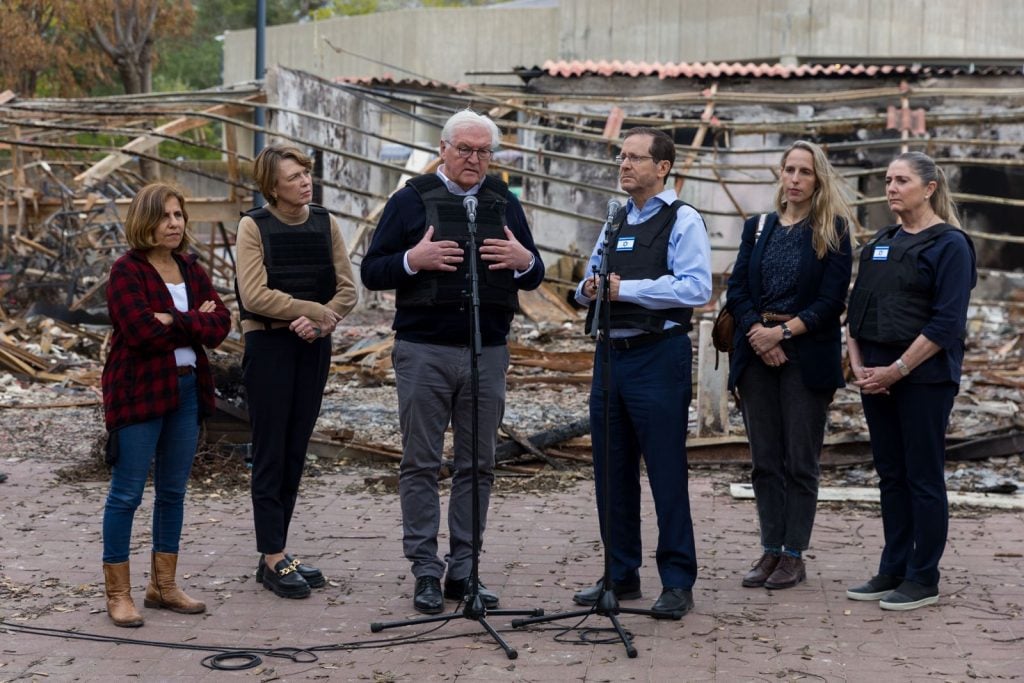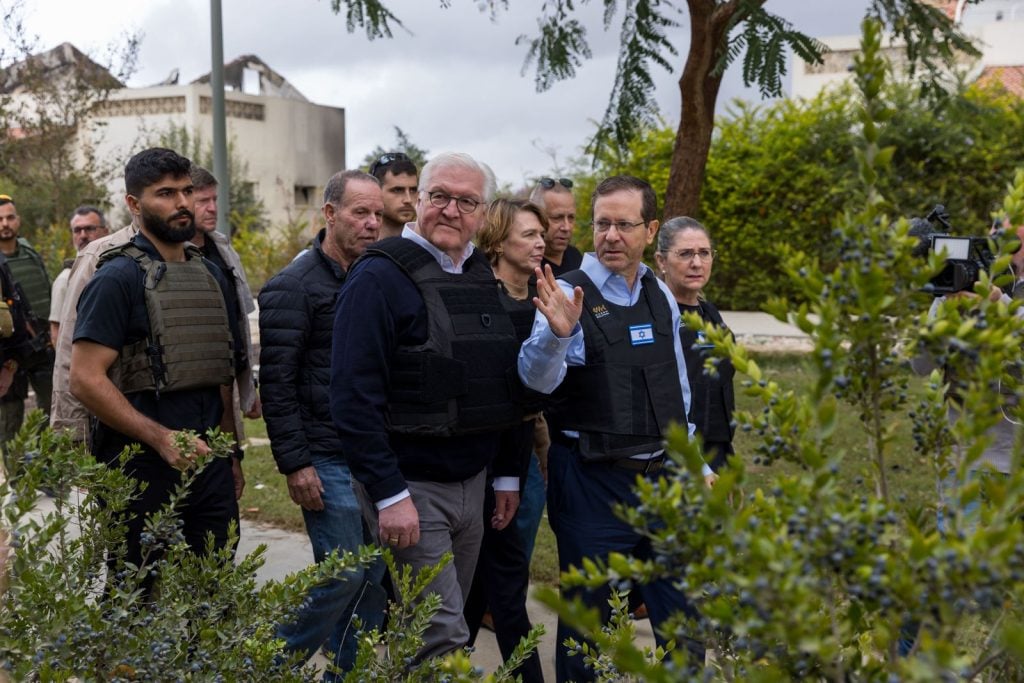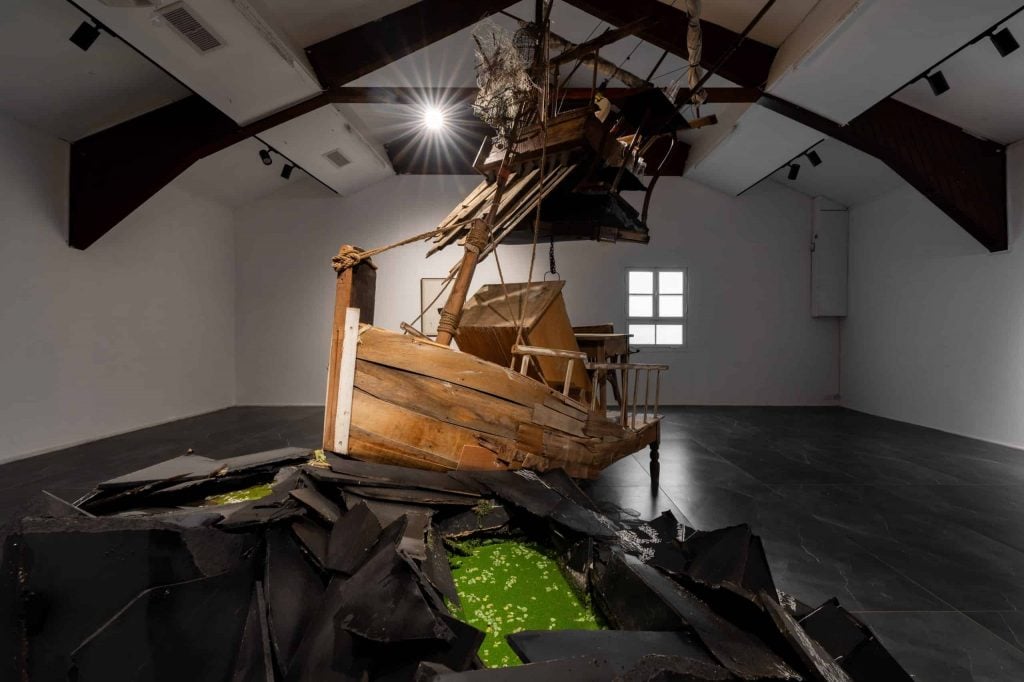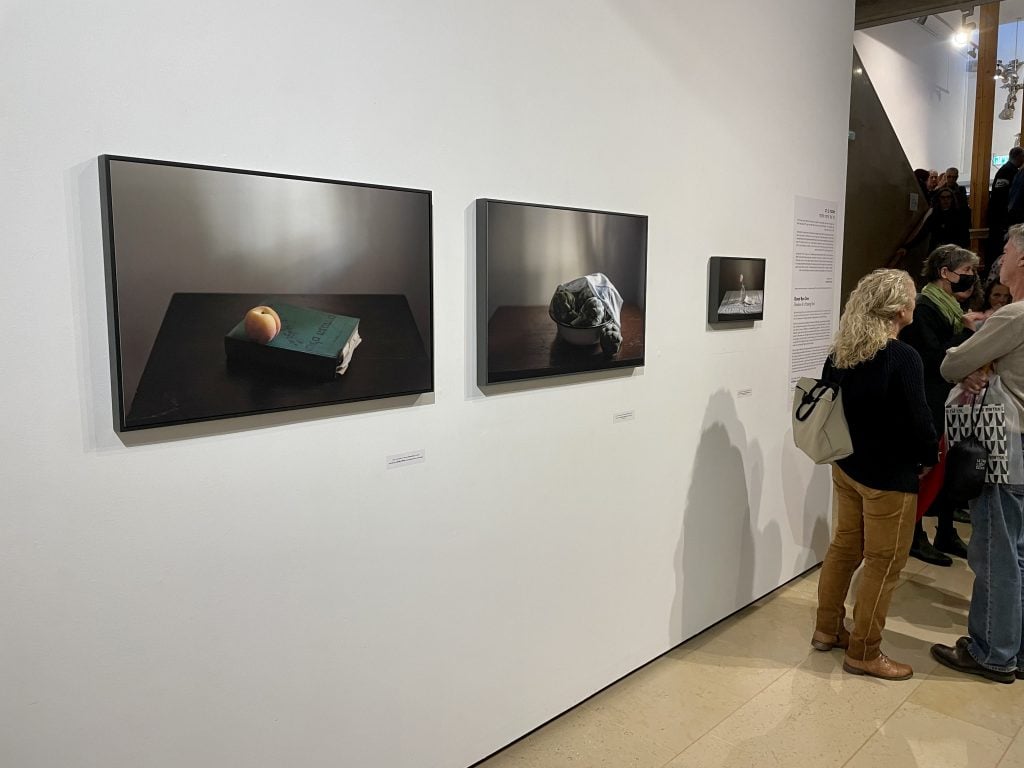Galleries
Israel’s Incinerated Be’eri Gallery Receives Funding From Germany to Rebuild
The €7 million gift from the German government is earmarked to reconstruct public buildings in Kibbutz Be’eri.

The €7 million gift from the German government is earmarked to reconstruct public buildings in Kibbutz Be’eri.

Karen Chernick

The loss of life and devastation caused by the Hamas attack on October 7 is manifest everywhere at Kibbutz Be’eri. As one of the towns hardest hit that day, its community of 1,200 residents had at least 89 people killed and at least 27 taken hostage, alongside destruction to homes and other property. The revival of ravaged arts institutions may seem low on the list of immediate priorities in such a ruined place, but it is intentionally at Be’eri that the German government has allocated €7 million to rebuild public buildings, including the art gallery incinerated by Hamas. The gift was announced by German President Frank-Walter Steinmeier on November 27, during a visit to Be’eri accompanied by Israeli President Isaac Herzog.
“Being here means that we are able to witness how much this soul of Israel was touched and destroyed by the attack of Hamas on Israeli people and the Kibbutz of Be’eri and the neighboring kibbutzim close by,” Steinmeier said in front of the gallery’s ruins, following his tour. “I think what we have to do is to think about the next months, next years, when people are returning to the Kibbutz of Be’eri, and I think they need a sort of anchor.”

German President Frank-Walter Steinmeier and Israeli President Isaac Herzog visit Kibbutz Be’eri. Photo Liron Moldovan.
The German grant, to be used in collaboration with Liebling Haus in Tel Aviv, is earmarked to reconstruct a community center for elderly residents and a cultural center which includes the gallery. This gift and other initiatives recognize the extent to which Be’eri symbolizes the massacre of October 7. The kibbutz’s gallery, by extension, reflects the spirit of the region’s residents.
Founded in 1986 by the late Orit Svirsky, a victim of the October 7 attack, Be’eri Gallery was located in the former kibbutz cafeteria (a building with historic preservation status) and has hosted over 400 exhibitions. “The gallery earned recognition for attracting prominent Israeli artists, despite its distance from the center,” said Amitai Mendelsohn, senior curator and head of the Israeli art department at the Israel Museum, in reference to the gallery’s reputation, despite its geographic distance from the cultural hubs of Tel Aviv and Jerusalem.
Displaced along with the rest of the kibbutz residents since October 7, the director and curator of the gallery had not yet planned for its future. “We weren’t dealing with [the idea of rebuilding] yet, it just wasn’t important in the grand scheme of priorities,” said Sofie Berzon MacKie, an artist and curator of the Be’eri Gallery, who was recently named director. She added that waiting to revive the gallery until both her and the gallery’s longtime director Ziva Jelin could return home with other kibbutz members (an estimated timeline suggests three years), could mean there wouldn’t be a gallery at all.

Nivi Alroy and Atar Geva, Earth Diver exhibition at Be’eri Gallery, February 17–March 24, 2023. Photo by Daniel Hanoch
“The presidents were looking for a symbolic project, one that represented the human spirit and the hope for rehabilitation,” noted Berzon MacKie. “The gallery was a natural choice, in addition to all the other important rehabilitation. To place weight on the human spirit, what it means to be human, and what spaces there are for hope—that was what drove this decision.”
Even before President Steinmeier announced the grant, the Israeli arts community has rallied to support Be’eri, its gallery, and its artists. In November the Israel Museum installed a landscape painting by Jelin (who is a practicing artist), which was pierced by bullets and shrapnel when Hamas threw a grenade into her studio.
The Be’eri Gallery has been offered a temporary home in Tel Aviv for the next three years, with rent waived by the landlord and the Tel Aviv Municipality forgoing property tax. The Tel Aviv-based Nassima Landau Art Foundation is currently hosting a fundraising exhibition with proceeds supporting Kibbutz Be’eri (and a charity that helps at-risk youth). In late December, the Mishkan Museum of Art will mount “Kibbutz Anxiety”, a solo exhibition of heavily impastoed landscape paintings of Be’eri by Haran Kislev, a native and resident of the kibbutz. It will be the first in a series of exhibitions displaying artworks that survived the ravages of October 7.

Installation shot of Osnat Ben Dov’s exhibition “Shadow of a Passing Bird” recreated at Janco Dada Museum.
In parallel, the solo exhibition of photographic still lifes by Osnat Ben Dov that was on view at Be’eri Gallery before the Hamas attack, Shadow of a Passing Bird, has been recreated and hosted by the Janco Dada Museum in northern Israel. “We’re people of the arts. You know, the redundant ones,” Janco Dada Museum director and chief curator Raya Sommer-Tal said, at an opening event for the exhibition. “When I read that the gallery burned in Be’eri, I felt that helplessness and then said, ‘just a minute, there is actually something that we, as a museum, can [do to] help’.”
President Steinmeier and the German parliament join these combined efforts to aid and rehabilitate Be’eri’s creative community. “Bee’ri is a very old kibbutz with a long history,” a press officer of the German Federal Ministry for Housing, Urban Development and Building shared over email. “It must have a future for all its inhabitants and needs to be rebuilt.”
More Trending Stories:
Art Dealers Christina and Emmanuel Di Donna on Their Special Holiday Rituals
Stefanie Heinze Paints Richly Ambiguous Worlds. Collectors Are Obsessed
Inspector Schachter Uncovers Allegations Regarding the Latest Art World Scandal—And It’s a Doozy
Archaeologists Call Foul on the Purported Discovery of a 27,000-Year-Old Pyramid
The Sprawling Legal Dispute Between Yves Bouvier and Dmitry Rybolovlev Is Finally Over